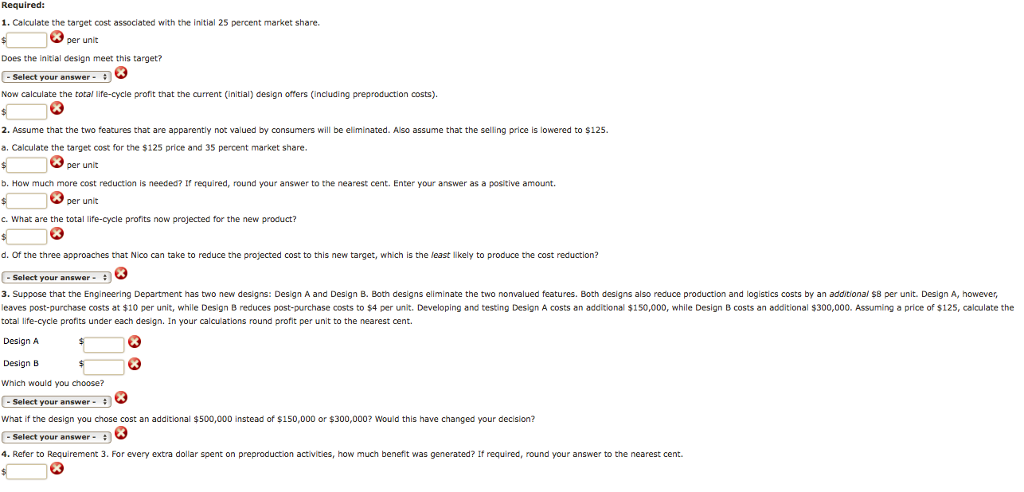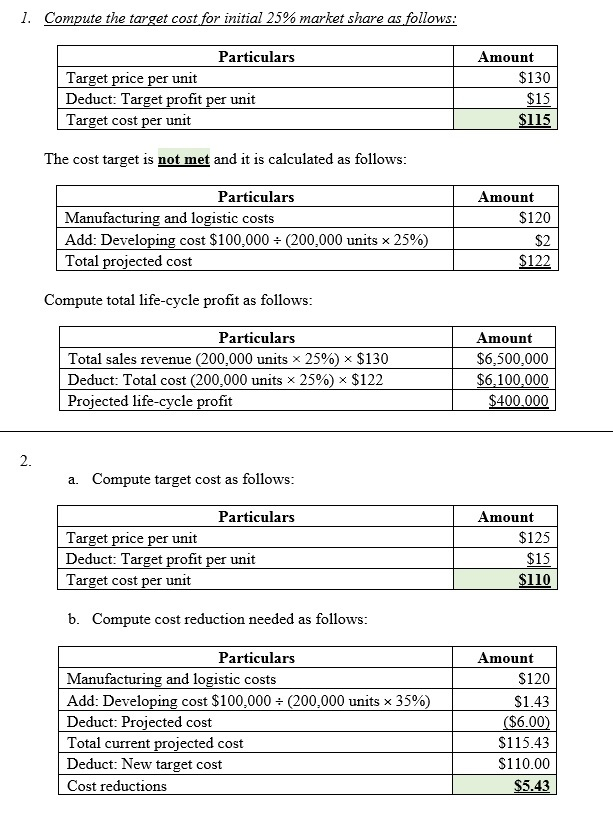Life-Cycle Cost Management and Target Costing Nico Parts, Inc., produces electronic products with short life cycles (of less than two years). Development has to be rapid, and the profitability of the products is tied strongly to the ability to find designs that will keep production and logistics costs low. Recently, management has also decided that post-purchase costs are important in design decisions. Last month, a proposal for a new product was presented to management. The total market was projected at 200,000 units (for the two-year period). The proposed selling price was $130 per unit. At this price, market share was expected to be 25 percent. The manufacturing and logistics costs were estimated to be $120 per unit. Upon reviewing the projected figures, Brian Metcalf, president of Nico, called in his chief design engineer, Mark Williams, and his marketing manager, Cathy McCourt. The following conversation was recorded: BRIAN: Mark, as you know, we agreed that a profit of $15 per unit is needed for this new product. Also, as I look at the projected market share, 25 percent isn’t acceptable. Total profits need to be increased. Cathy, what suggestions do you have? CATHY: Simple. Decrease the selling price to $125 and we expand our market share to 35 percent. To increase total profits, however, we need some cost reductions as well. BRIAN: You’re right. However, keep in mind that I do not want to earn a profit that is less than $15 per unit. MARK: Does that $15 per unit factor in preproduction costs? You know we have already spent $100,000 on developing this product. To lower costs will require more expenditure on development. BRIAN: Good point. No, the projected cost of $120 does not include the $100,000 we have already spent. I do want a design that will provide a $15-per-unit profit, including consideration of preproduction costs. CATHY: I might mention that post-purchase costs are important as well. The current design will impose about $10 per unit for using, maintaining, and disposing our product. That’s about the same as our competitors. If we can reduce that cost to about $5 per unit by designing a better product, we could probably capture about 50 percent of the market. I have just completed a marketing survey at Mark’s request and have found out that the current design has two features not valued by potential customers. These two features have a projected cost of $6 per unit. However, the price consumers are willing to pay for the product is the same with or without the features.
Required: 1. Calculate the target cost associated with the initial 25 percent market share. per unit Does the initial design meet this target? Select your answer- Now calculate the total life-cycle profit that the current (initial) design offers (including preproduction costs). 2. Assume that the two features that are apparently not valued by consumers will be eliminated. Also assume that the selling price is lowered to $125 a. Calculate the target cost for the $125 price and 35 percent market share per unit b. How much more cost reduction is needed? If required, round your answer to the nearest cent. Enter your answer as a positive amount. per unit c. what are the total life-cycle profits now projected for the new product? d. Of the three approaches that Nico can take to reduce the projected cost to this new target, which is the least likely to produce the cost reduction? Selact 3. Suppose that the Engineering Department has two new designs: Design A and Design B. Both designs eliminate the two nonvalued features. Both designs also reduce production and logistics costs by an addtional $8 per unit. Design A, however leaves post-purchase costs at 10 per unit, while Design B educes post-purchase costs to $4 per unit Developing and testing Design A costs an additional $150 000 while Design B costs an additional $300,000. Assuming a price of $125 calculate the total life-cycle profits under each design. In your calculations round profit per unit to the nearest cent. Design A your answer . Design B Which would you choose? Select your answer – What if the design you chose cost an additional $500,000 instead of ş150,000 or $300,000? Would this have changed your decision? Select your answer . . Refer to Requirement 3. For every extra dollar spent on preproduction activities, how much benefit was generated? If required, round your answer to the nearest cent.
Expert Answer




